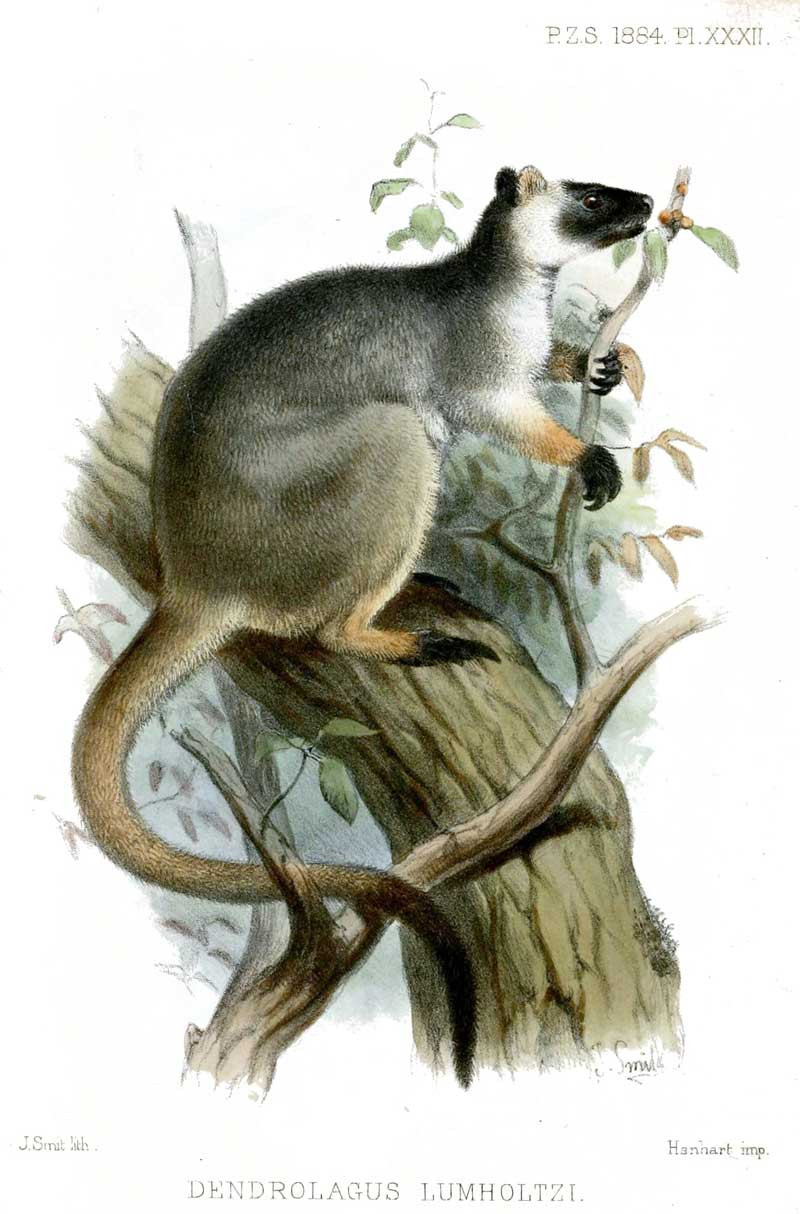
Superregnum: Eukaryota
Cladus: Unikonta
Cladus: Opisthokonta
Cladus: Holozoa
Regnum: Animalia
Subregnum: Eumetazoa
Cladus: Bilateria
Cladus: Nephrozoa
Superphylum: Deuterostomia
Phylum: Chordata
Subphylum: Vertebrata
Infraphylum: Gnathostomata
Megaclassis: Osteichthyes
Cladus: Sarcopterygii
Cladus: Rhipidistia
Cladus: Tetrapodomorpha
Cladus: Eotetrapodiformes
Cladus: Elpistostegalia
Superclassis: Tetrapoda
Cladus: Reptiliomorpha
Cladus: Amniota
Cladus: Synapsida
Cladus: Eupelycosauria
Cladus: Sphenacodontia
Cladus: Sphenacodontoidea
Cladus: Therapsida
Cladus: Theriodontia
Subordo: Cynodontia
Infraordo: Eucynodontia
Cladus: Probainognathia
Cladus: Prozostrodontia
Cladus: Mammaliaformes
Classis: Mammalia
Subclassis: Trechnotheria
Infraclassis: Zatheria
Supercohors: Theria
Cohort: Metatheria
Cohors: Marsupialia
Cladus: Australidelphia
Cladus: Eomarsupialia
Ordo: Diprotodontia
Subordo: Macropodiformes
Familia: Macropodidae
Subfamilia: Macropodinae
Genus: Dendrolagus
Species: Dendrolagus lumholtzi
Name
Dendrolagus lumholtzi Collett, 1884
Type locality: Australia, Queensland, Herbert Vale
References
Proc. Zool. Soc. Lond. 1884: 387.
Dendrolagus lumholtzi in Mammal Species of the World.
Wilson, Don E. & Reeder, DeeAnn M. (Editors) 2005. Mammal Species of the World – A Taxonomic and Geographic Reference. Third edition. ISBN 0-8018-8221-4.
Vernacular names
English: Lumholtz's Tree-kangaroo
français: dendrolague de Lumholtz
magyar: Lumholtz-kúszókenguru
日本語: カオグロキノボリカンガルー
Lumholtz's tree-kangaroo (Dendrolagus lumholtzi) is a rare, long-tailed bear-like mammal found in rainforests in northeastern Australia. Like most tree-kangaroos (genus Dendrolagus), it lives alone in trees and feeds on plant matter.[2] It belongs to the macropod family (Macropodidae) with kangaroos, and carries its young in a pouch like other marsupials. It is threatened by climate change and diseases, and is found in the hilly, fertile Atherton Tableland in Queensland.
Name
The species name lumholtzi is after the Norwegian explorer Carl Sofus Lumholtz (1851–1922),[3] who was the first European to record a specimen in 1883. The local indigenous Dyirbal and Yidiny language name may have been either "mabi" or "mapi".[4]
Description and habitat
It is the smallest of all tree-kangaroos, with males weighing an average of 7.2 kg (16 lbs) and females 5.9 kg (13 lbs).[5] Its head and body length ranges from 480–650 mm, and its tail, 600–740 mm.[6] It has powerful limbs and has short, grizzled grey fur. Its muzzle, toes and tip of tail are black.
The Lumholtz's tree-kangaroos colonizes a variety of habitats, as long as they are flush with food and have stable and adaptable structural features.[7]
Social behaviour
Lumholtz's tree-kangaroo are generally solitary animals, with the exception of male–female mating and the long, intimate mother–joey relationship. Each kangaroo maintains a "home range" and will be hostile towards a member of the same sex that enters it (the one exception seems to be non-hostile encounters between adult males and their male offspring). Thus, the male will protect his own range, and visit the ranges of the females in his group. Mating takes place in episodes of about twenty minutes, and is often quite aggressive.
Status
The Lumholtz's tree-kangaroo is classified as near-threatened [2] by the IUCN, and authorities consider it as rare.[8] It was historically impacted by habitat loss through logging and land clearing. Currently, it is threatened by non-native diseases and by climate change, which causes temperature extremes and severe weather.[2]
Blindness
Lithograph of Dendrolagus lumholtzi by Joseph Smit, from Proceedings of the general meetings for scientific business of the Zoological Society of London, 1884
In June 2019, it was reported that many Lumholtz's tree-kangaroos were going blind. Normally almost invisible in the treetops, they were being found in schools, sheds and in the middle of roads, unable to see and confused. Veterinarian Andrew Peters, from Charles Sturt University, said he had found evidence of optic nerve and brain damage, suggesting that a new viral infection was involved.
Karen Coombes, who has cared for injured tree kangaroos on her property west of Cairns for two decades, said she thought successive dry periods in the area were contributing to the eye problems. Her theory is that, because the animals only eat the leaves of the rainforest trees they inhabit, which are always fairly toxic, the drier-than-normal weather over recent years could have caused the toxins in the leaves to become more concentrated.[9] No toxin has been identified and this hypothesis remains speculative and unsubstantiated.
Other work by wildlife veterinarian, Amy Shima and wildlife biologist, Roger Martin (author of Tree-kangaroos of Australia and New Guinea), does not support these claims. Their fieldwork spanning 5 years has found no convincing evidence of widespread blindness in Lumholtz's tree-kangaroo. Working with a comparative veterinary ocular pathologist from a university in the United States, Shima has looked at nearly 100 eyes from Lumholtz's tree-kangaroo carcasses (primarily road-killed animals) and has found no evidence of widespread blindness or pathology. These findings were recently presented in a poster presentation at the international Wildlife Disease Association conference.
References
Groves, C. P. (2005). Wilson, D. E.; Reeder, D. M. (eds.). Mammal Species of the World: A Taxonomic and Geographic Reference (3rd ed.). Baltimore: Johns Hopkins University Press. p. 60. ISBN 0-801-88221-4. OCLC 62265494.
Woinarski, J.; Burbidge, A.A. (2016). "Dendrolagus lumholtzi". IUCN Red List of Threatened Species. 2016: e.T6432A21957815. doi:10.2305/IUCN.UK.2016-1.RLTS.T6432A21957815.en. Retrieved 25 September 2021.
"Carl Sofus Lumholtz - biography". Biography. Australian National Herbarium. 17 December 2009. Retrieved 3 November 2010. "citing: J.W. Cribb, The Queensland Naturalist, Vol.44, Nos.1-3, 2006"
"Treat - Mabi Forest".
Flannery, Timothy F; Martin, Roger; Szalay, Alexandria (1996). Tree Kangaroos: A Curious Natural History. Australia: Reed Books. ISBN 0-7301-0492-3. Archived from the original on 2009-02-08. Retrieved 2006-11-25.
Cronin, Leonard (2000). Australian Mammals: Key Guide (Revised ed.). Annandale, Sydney, Australia: Envirobooks. ISBN 0-85881-172-3.
Heise-Pavlov, Sigrid; Rhinier, Jaqueline; Burchill, Simon (January 17, 2018). "The use of a replanted riparian habitat by the Lumoltz's Tree-kangaroo (Dendrolagus lumholtzi)". Ecological Management & Restoration. 19 (1): 76–80. doi:10.1111/emr.12282.
"Lumholtz's tree-kangaroo". Queensland Government. 2005-08-30. Archived from the original on 2009-04-27. Retrieved 2006-10-09.
Sexton-McGrath, Kristy (2019-06-17). "Lumholtz's tree kangaroo blindness mystifies experts, but toxic leaves could be to blame". ABC News. Australian Broadcasting Corporation. Retrieved 2019-06-17.
Simon & Schuster's Guide to Mammals, entry 30
Behaviour Patterns of Lumholtz's Tree Kangaroo
The Tree Kangaroo and Mammal Group, Inc.
Retrieved from "http://en.wikipedia.org/"
All text is available under the terms of the GNU Free Documentation License

